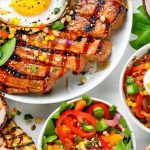Long workdays demand sustained energy and focus, but heavy meals can often lead to sluggishness and decreased productivity. The challenge isn’t necessarily avoiding food – it’s about choosing the right types of sustenance throughout the day to maintain optimal performance without sacrificing wellbeing. Many people fall into patterns of grabbing convenient, but ultimately unhelpful, snacks or skipping meals altogether, leading to energy crashes and difficulty concentrating. This article will explore how strategic light food pairings can be your allies during those long stretches at work, providing both physical nourishment and mental clarity.
The goal isn’t deprivation or restrictive dieting; it’s about mindful eating that supports your workday needs. Think of food as fuel – a high-quality, consistently supplied resource rather than sporadic bursts of sugar or excessive bulk. This approach requires considering not just what you eat but when and how it’s combined. Pairing foods strategically can help regulate blood sugar levels, prevent energy dips, and even boost cognitive function. It’s about building a sustainable system that helps you feel energized, focused, and capable throughout your entire workday, no matter how demanding it may be. If you suspect food sensitivities are impacting your ability to focus, consider food sensitivity testing for deeper insights.
Fueling Focus: The Power of Protein & Complex Carbohydrates
The cornerstone of sustained energy during long workdays lies in balancing protein with complex carbohydrates. Simple sugars offer a quick burst but are followed by a rapid decline, leaving you feeling worse than before. Complex carbs, on the other hand, provide a slower, more consistent release of glucose, while protein helps stabilize blood sugar and promotes satiety – that satisfying feeling of fullness that prevents mid-afternoon cravings. This combination isn’t just about avoiding crashes; it’s actively building resilience against them.
Consider these pairings:
– Apple slices with almond butter. The apple provides natural sugars for immediate energy, while the almond butter offers protein and healthy fats to sustain it.
– Whole-grain toast with avocado and a sprinkle of everything bagel seasoning. Avocado delivers healthy fats and fiber, while whole grains give you sustained carbohydrate release.
– Greek yogurt with berries and a small handful of granola. This combination provides protein from the yogurt, antioxidants from the berries, and a touch of crunch (and carbs) from the granola.
These aren’t restrictive choices; they’re about making thoughtful selections that support your body and mind. The key is to prioritize whole, unprocessed foods over sugary or heavily processed alternatives. The more natural the food source, the better it will serve you in the long run. Don’t underestimate the power of preparation – having these pairings readily available can prevent impulsive snacking on less desirable options when fatigue sets in. Understanding food density principles can also help minimize discomfort and maximize nutrient absorption.
Hydration & Light Refreshments: Beyond Water
While water is undeniably crucial for maintaining hydration and cognitive function, relying solely on water throughout a long workday can sometimes feel… insufficient. Incorporating light refreshments that contribute to both hydration and provide subtle energy boosts can be incredibly beneficial. Think beyond just thirst quenching – think about subtly replenishing electrolytes and adding a touch of flavor without the sugar crash.
Herbal teas are an excellent option, offering a calming effect while providing hydration. Peppermint tea is particularly effective for boosting alertness and aiding digestion. Infused water – water with slices of cucumber, lemon, or berries – can make staying hydrated more appealing. Consider also lightly flavored sparkling water as a refreshing alternative to sugary sodas. Hydration isn’t just about volume; it’s about making the process enjoyable and sustainable.
Another option is coconut water, which naturally contains electrolytes like potassium and magnesium, essential for maintaining energy levels. However, be mindful of portion sizes, as even natural sugars can impact blood sugar if consumed excessively. The goal here is to complement your water intake with subtle additions that enhance both hydration and overall wellbeing, rather than replacing it altogether. Remember, a well-hydrated brain is a more productive brain! If you experience issues like soft bowels after certain food combinations, consider adjusting your hydration and pairings accordingly.
Snack Strategies for Sustained Energy
Snacking doesn’t have to be a guilty pleasure; it can be a strategic component of maintaining energy levels throughout the day. The trick is to choose snacks that are nutrient-dense and avoid those that are high in sugar or processed ingredients. Planning ahead is key – resist the urge to raid the vending machine when hunger strikes by having healthy options readily available.
- Portion control is vital. Pre-portioning snacks into individual containers can help you avoid overeating.
- Focus on combinations that provide both protein and fiber, like a small handful of almonds with a few squares of dark chocolate (70% cacao or higher).
- Consider these options: Edamame pods, air-popped popcorn, carrot sticks with hummus, a hard-boiled egg, or a small serving of cottage cheese.
These snacks are designed to provide sustained energy and prevent cravings without causing a sugar crash. Snacking isn’t about indulging; it’s about maintaining consistent fuel levels. It’s also important to listen to your body – sometimes you need a snack, and sometimes you just need a glass of water or a short break from work. Incorporating micro-movement into your breaks can further enhance energy levels.
The Mid-Afternoon Slump: Combating the Dip
The mid-afternoon slump is a common experience for many people working long hours. It’s often characterized by feelings of fatigue, decreased concentration, and an overwhelming desire to nap. Instead of reaching for another cup of coffee (which can exacerbate anxiety and disrupt sleep), consider these strategies to combat the dip:
- Move your body: A short walk or some quick stretches can significantly improve energy levels and mental clarity.
- Re-evaluate your food pairing: If you’ve been relying on sugary snacks, switch to a protein-rich option like Greek yogurt with berries.
- Take a five-minute mindfulness break: Close your eyes, focus on your breath, and clear your mind. This can help reduce stress and improve concentration.
This isn’t about fighting the slump; it’s about managing it strategically. Recognizing that these dips are normal and having a plan to address them is crucial for maintaining productivity and wellbeing. Proactive measures are far more effective than reactive ones. Planning your meals according to low-ferment principles can also minimize digestive discomfort during these slumps.
Optimizing Your Food Prep for Workday Success
The most successful strategy for light food pairings during long workdays isn’t just about what you eat, but also about making it easy to implement. Dedicated food preparation can transform the process from a stressful chore into a seamless part of your routine.
- Batch cooking on the weekend is incredibly helpful. Prepare large quantities of healthy snacks and meals that you can easily grab throughout the week.
- Invest in reusable containers for portioning out snacks and lunches.
- Keep a well-stocked pantry with healthy options readily available, such as nuts, seeds, dried fruit, and whole-grain crackers.
- Plan your pairings in advance to avoid impulsive choices when hunger strikes.
By streamlining the food preparation process, you eliminate barriers to success and make it easier to maintain consistent energy levels throughout your long workdays. Preparation is the key to sustainable healthy habits. A little bit of effort upfront can save you a lot of stress and improve your productivity in the long run. Don’t forget to incorporate post-indulgence options when planning for a balanced week!


















